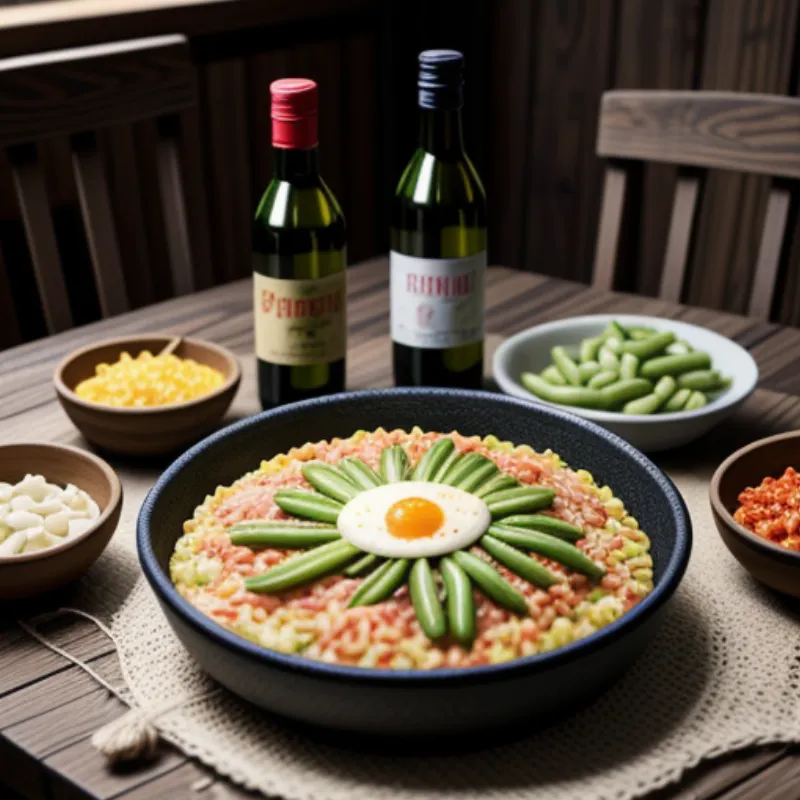Vegetable paella is a symphony of flavors and colors, a celebration of fresh vegetables bathed in the warm embrace of saffron-infused rice. Originating from the sun-drenched fields of Valencia, Spain, paella has transcended borders, becoming a beloved dish worldwide. This vegan version honors the traditional recipe while showcasing the versatility and deliciousness of plant-based cuisine.
Imagine tender artichoke hearts, sweet bell peppers, and earthy mushrooms, all simmered to perfection in a rich, flavorful broth. Each bite is an explosion of textures and tastes, a delightful journey through the Mediterranean landscape. Whether you’re a seasoned paella enthusiast or a curious newcomer, this recipe will guide you through each step, ensuring a truly unforgettable culinary experience.
Ingredients
For the Paella:
- 1 tablespoon olive oil
- 1 onion, chopped
- 2 cloves garlic, minced
- 1 red bell pepper, chopped
- 1 yellow bell pepper, chopped
- 1 cup chopped green beans
- 1 cup artichoke hearts, quartered
- 1 cup mushrooms, sliced
- 1 teaspoon smoked paprika
- 1/2 teaspoon saffron threads
- 1 cup paella rice (bomba or calasparra preferred)
- 2 cups vegetable broth
- Salt and pepper to taste
For Garnish:
- Fresh parsley, chopped
- Lemon wedges
Equipment
- Paella pan or large skillet
- Wooden spoon
- Measuring cups and spoons
Instructions
-
Saffron Infusion: In a small bowl, steep saffron threads in 1/2 cup of warm vegetable broth for at least 15 minutes. This will extract the maximum flavor and color from the saffron.
-
Sautéing the Vegetables: Heat olive oil in the paella pan over medium heat. Add chopped onion and cook until softened, about 5 minutes. Stir in garlic, red bell pepper, and yellow bell pepper and cook for another 5 minutes.
-
Adding the Remaining Ingredients: Stir in green beans, artichoke hearts, and mushrooms. Cook for 5 minutes, then add smoked paprika and cook for another minute until fragrant.
-
Incorporating the Rice: Pour in the paella rice and toast it lightly for about 2 minutes, stirring constantly.
-
Adding Broth and Saffron: Add the remaining 1 1/2 cups of vegetable broth and the saffron infusion to the pan. Season generously with salt and pepper.
-
Simmering the Paella: Bring the mixture to a boil, then reduce the heat to low, cover, and simmer for 15-20 minutes, or until the rice is cooked through and the liquid is absorbed.
-
Resting and Serving: Once the rice is cooked, remove the pan from the heat and let it rest, covered, for 5-10 minutes. This allows the flavors to meld and the rice to finish absorbing any remaining liquid. Garnish with fresh parsley and serve immediately with lemon wedges.
 Vegetable Paella
Vegetable Paella
Tips and Notes
- Rice Selection: For authentic paella, use Spanish bomba or calasparra rice. These varieties absorb liquid exceptionally well without becoming mushy. If unavailable, Arborio rice is a decent substitute.
- Broth Adjustment: Depending on the type of rice used, you might need to adjust the amount of broth. Start with the recommended amount and add more if necessary.
- Socarrat: For a truly authentic touch, aim for a thin layer of crispy rice at the bottom of the pan, known as socarrat. To achieve this, increase the heat slightly during the last few minutes of cooking.
- Get Creative with Vegetables: Feel free to customize your vegetable paella with your favorite seasonal vegetables. Asparagus, peas, zucchini, and cherry tomatoes would all be delicious additions.
“Paella is all about celebrating fresh, seasonal ingredients,” says Chef Maria Gomez, a renowned Spanish chef specializing in traditional cuisine. “Don’t be afraid to experiment and make it your own.”
 Paella Ingredients
Paella Ingredients
Conclusion
Vegetable paella is a testament to the fact that vegetarian cuisine can be just as flavorful and satisfying as its meat-based counterparts. With its vibrant colors, aromatic spices, and medley of fresh vegetables, this dish is a true feast for the senses. So gather your ingredients, put on your apron, and embark on a culinary adventure to the heart of Spain. Don’t forget to share your culinary masterpiece with us! We’d love to hear about your paella-making experience in the comments below.
